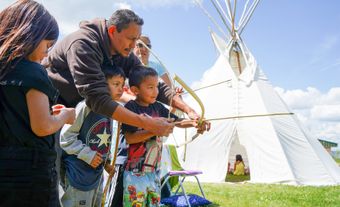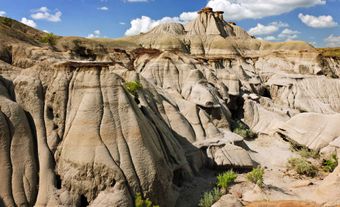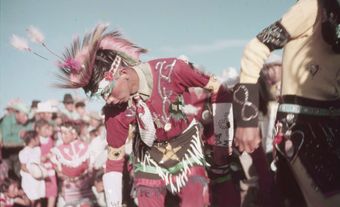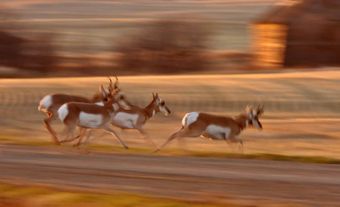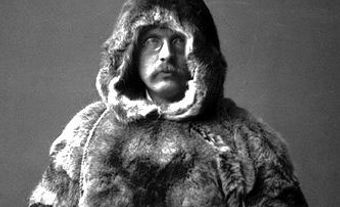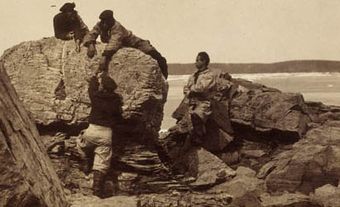Alberta, the westernmost of Canada's three Prairie provinces, shares many physical features with its neighbours to the east, Saskatchewan and Manitoba. The Rocky Mountains form the southern portion of Alberta's western boundary with British Columbia. Alberta was named after Princess Louise Caroline Alberta, fourth daughter of Queen Victoria. The province is home to the country’s largest deposits of oil and natural gas.
Geography

Alberta is divided by three of Canada’s seven physiographic regions. These three regions are the Cordillera, Interior Plains and Canadian Shield. However, the vast majority of the province falls within the Interior Plains region. The Interior Plains may be further divided into prairie grassland, parkland and boreal forest. The prairie portion includes most of southern Alberta. This gently rolling grassland is relatively dry and mostly treeless. The parkland region predominates in central Alberta. This area varies from the flatland of old lake bottoms to rolling landscape with numerous lakes and depressions. The boreal forest region covers the northern half of the province. Here great rivers and lakes dominate the landscape, draining northward to the Arctic Ocean. In Alberta’s southwest corner an area of foothill ridges rise to the Rocky Mountains, forming part of Canada’s Cordillera region.
The prairie region of southern Alberta includes both short-grass and mixed-grass. These grasses include blue grama and western wheat grass. The parkland regions of central Alberta and the Peace River country are characterized by tall grasses and aspen trees.
The boreal region of northern Alberta includes forests of aspen and white birch in the south, and white spruce, larch and black spruce farther north. Balsam fir and jack pine are also found in eastern areas. Alpine fir and lodgepole pine grow in the west. Alpine fir, white spruce and lodgepole pine dominate the lower elevations of the Rocky Mountains. At higher elevations, scattered stands of black spruce and alpine larch are interspersed with lichens and alpine flowers in alpine meadows.
The small Milk River basin in southeastern Alberta drains through the Missouri and Mississippi rivers south to the Gulf of Mexico. The rest of southern Alberta is drained by the South and North Saskatchewan river basins east to Hudson Bay via the Nelson River system. Northern Alberta is dominated by the Athabasca, Hay and Peace river basins. These basins drain north through the Mackenzie River to the Arctic Ocean. Lake Claire and Lesser Slave Lake are the two largest lakes entirely within Alberta. (See also Geography of Alberta.)
People
Urban Centres
Alberta's population in 2021 was 82.3 per cent urban — a near reversal since the first census of 1901, when 75 per cent of the population was rural. The trend toward urbanization accelerated during the Second World War and again increased in the postwar boom years.
The most notable feature of urban growth is concentration in the two metropolitan centres, Calgary in southern Alberta and Edmonton in central Alberta. In 1901, 9 per cent of Alberta’s population lived in either Edmonton or Calgary. By 1951, 31 per cent of Alberta’s population lived in Edmonton or Calgary. As of 2016, about 2.2 million people lived in Edmonton or Calgary, or 53 per cent of the province. Edmonton's surrounding area includes most of central and northern Alberta, and parts of the Peace River region of northeastern British Columbia. Calgary's surrounding area includes all of the province south of Red Deer, plus a portion of southeastern British Columbia.
Alberta's secondary urban centres have been affected by the metropolitan growth of Edmonton and Calgary. St Albert, Sherwood Park, Leduc, Fort Saskatchewan and Spruce Grove have become satellite communities of Edmonton. While Strathmore, Olds, Cochrane, Chestermere, High River, Airdrie and Canmore have become satellite communities of Calgary. Lethbridge, Red Deer and Medicine Hat in the south have been able to preserve their regional importance only at the expense of smaller communities like Rocky Mountain House and Taber. Fort McMurray in the northeast and Grande Prairie in the northwest have escaped the direct metropolitan influences of Edmonton and Calgary, largely due to their relative distance and isolation.
Reserves and Métis Settlements
There are 138 reserves in Alberta. Members of Alberta’s 47 First Nations live in these communities. In addition, two First Nations — Salt River and Onion Lake Cree — are based in other provinces or territories, but have reserve land in Alberta. In 2019, there were 131,697 registered Indians living in Alberta, 58 per cent of whom lived on reserves. The remainder live in other municipalities. (See also Reserves in Alberta.)
While historically the Canadian government assigned reserves to First Nations people and not Métis or Inuit, Alberta is the only province in which Métis people were given a collective land base, known as the Métis Settlements. The largest of the eight settlements in terms of area is Paddle Prairie Metis Settlement.
Labour Force
Historically, Alberta has had an unemployment rate lower than the national rate, and often the lowest rate in the country. For example, the province's unemployment rate in 2014 was 4.7 per cent, second only to Saskatchewan. However, because Alberta’s economy is intrinsically tied to oil and gas production, rises and falls in oil prices have a profound effect on employment. In 2015, oil prices dropped dramatically, contributing to a rise in annual unemployment to 9 per cent in 2016. Historically, such plunges in oil prices are quickly followed by an upward swing. Such was the case, for example, following low oil prices post 9/11 and again after the 2008 financial crisis (see also Economy). How the province will recover from this most recent drop remains to be seen. In 2021, the unemployment rate had reached 11.5 per cent.
Language and Ethnicity
The most commonly cited ethnic origin in Alberta is English, followed by German and Scottish, according to the 2021 Census. The first great wave of immigration dates from 1896–1914, which drew tens of thousands of European settlers speaking a variety of languages and representing many religious groups. Since the 1970s, immigrants from Asia have been arriving in greater numbers.
This shift in immigration is reflected in Alberta’s visible minority population. The province has one of the largest such populations in the country, at 27.8 per cent (the two provinces with a higher percentage, British Columbia and Ontario, both at about 34 per cent). Of the visible minority population in Alberta, the largest communities are South Asian, Chinese, Black and Filipino.
Indigenous people account for 6.8 per cent of Albertans — the fourth largest Indigenous community among the provinces.
Religion
Half of Albertans are Christian, with about 48.3 per cent identifying with a Christian denomination in the 2021 census. In the same year, the largest non-Christian groups were Muslim (4.8 per cent of the population), Sikh (2.5 per cent), Buddhist (1 per cent) and Hindu (1.9 per cent). Minor religious groups of greater prominence in Alberta than elsewhere in Canada include the Church of Jesus Christ of Latter-day Saints (see Mormon Church), Mennonites and Hutterites. In 2021, approximately 40 per cent of the Albertan population did not identify any religious affiliation.
History
Indigenous Peoples
In the late 18th century southern Alberta was occupied by Indigenous peoples, including the Blackfoot, Blood, Peigan and Gros Ventre. The Kootenay and other more western groups made regular bison-hunting expeditions into the area, while more southerly groups, like the Crow, came to the region to engage in warfare and trade. Along the North Saskatchewan River were the Tsuu T’ina (Sarcee), an offshoot of the Beaver who occupied central and northern Alberta. The northern fringes of modern day Alberta were inhabited by the Slavey (Slave Dene).
These Indigenous peoples felt the effects of European culture long before direct contact occurred. Metal tools and weapons brought by the major European trading groups, including the British Hudson’s Bay Company and the Montréal-based North West Company, were traded and re-traded for furs westward across the continent to the Prairies, reaching the isolated region of southern Alberta in the mid-18th century; similarly, and also by the mid-1700s, the horse moved north from Spanish Mexico, and became fully integrated in the hunting culture of the Blackfoot.
Gradually groups close to Hudson Bay adopted European trade goods into their everyday material culture. Consequently, these groups sought new sources of furs as over-hunting began to decrease the availability of fur to trade with major fur companies. More than other nations, the Cree and Assiniboine (including the Stoney) acted as go-betweens for the Hudson Bay Company and the isolated Alberta Indigenous groups in the 1700s. They moved up the North Saskatchewan River to trade, forcing the Sarcee and Blackfoot tribes south, and the Beaver north. The Chipewyan entered the northeast corner of Alberta, pushing the Beaver back towards the mountains. By the early 1800s, the Gros Ventre had moved south of the 49th parallel. These shifts were the result of new trade patterns facilitated by European exploration and the westward expansion of Central Canada’s fur companies.
Exploration
The first European known to have reached present-day Alberta was Anthony Henday, a Hudson Bay Company employee, who, accompanied by a band of Cree, travelled through the Red Deer area and likely spent the latter months of the winter near the present site of Edmonton in 1754–55. In 1778, Peter Pond, an employee of the North West Company travelled down the Athabasca River and established the first fur trading post in the province. Fort Chipewyan, on Lake Athabasca, was founded in 1788 and served as the jumping-off point for Alexander Mackenzie’s historic trip down the Mackenzie River in 1789, and his journey up the Peace River and through the Rocky Mountains to the Pacific Ocean four years later.
The Hudson's Bay Company countered the emerging dominance of the North West Company in northern Alberta by sending Peter Fidler and David Thompson to explore and map the Athabasca and North Saskatchewan rivers in the 1790s and early 1800s. The Hudson Bay Company and the North West Company built competing posts throughout northern and central Alberta until 1821, when the rival companies merged. Neither company successfully penetrated the southern half of the province, which lacked forests and thus valuable beaver furs.
By the middle of the 19th century, Christian missionaries began to challenge the fur traders for possession of the territory. Methodist Robert Rundle became the first resident cleric in what is now Alberta in 1840. He was followed two years later by the Roman Catholic Father Jean-Baptiste Thibault. Missionary activity peaked in the third quarter of the century, and included the work of Catholic Albert Lacombe and the Methodist father-and-son team of George and John McDougall.
Around the same time in American territory, an expanding northwest fur trade, led by the American Fur Trade Company, became increasingly interested in southern Alberta. In the mid-19th century American ‘free traders’ began moving north from the Fort Benton trading post in Montana Territory in order to trade with several Indigenous nations, particularly the Blackfoot peoples, for bison hides. By the late 1860s, the American market for bison-hide robes greatly expanded, culminating in a mass influx of free traders across the border. These traders used ‘whiskey,’ a deadly combination of alcohol, dyes, medicines and poisons, as their primary trade item. Death, due to consumption, poisoning, violence, famine and disease, the effects of increasing alcohol dependence and social disintegration brought by the expanding liquor trade, plagued the Blackfoot, plunging the region into violence.
Settlement
During the 1850s and 1860s, while the liquor trade was emerging, the British and Canadian governments, realizing that the Hudson Bay Company’s license would be terminated in 1870, began investigating the agricultural potential of the Northwest. In 1857, an expedition headed by British Captain John Palliser, and one led by Henry Youle Hind, explored the Northwest. Their reports were, in part, responsible for the British government refusing to renew the Hudson Bay Company license, as the fur trade was becoming less lucrative and settlement more likely. While Palliser was pessimistic about the potential of the region, the Canadian government, as well as land-hungry Canadian expansionists, envisioned an agricultural hinterland in the region. However, the Canadian government first had to obtain the land from the Hudson Bay Company, halt the liquor trade, open the region to peaceful settlement and establish transportation infrastructure to tie the region to central Canada.
On 23 June 1870, the Canadian government took possession of the entirety of the Hudson Bay Company’s territory, including all of the future province of Alberta. The following year the region between the new Province of Manitoba and the Rocky Mountains was organized as the Northwest Territories of Canada, with its administrative centre first at Winnipeg, then at Battleford and finally at Regina. The Dominion Lands Policy of 1872 created the legal framework to begin settling and cultivating the land.
In 1874, after dozens of reports by missionaries, administrators and explorers highlighting the violence and dangers present in southern Alberta as a result of the American-dominated bison robe and liquor trade, the Canadian government moved to halt the exchange of liquor, establish law and order, and ensure peaceful settlement. In July 1874,, the North-West Mounted Police, led by George French and James Macleod, marched west across the Prairies to the present-day area of Lethbridge. They established their first Alberta post at Fort Macleod in 1874. In 1875, the North-West Mounted Police established forts at Calgary and in Edmonton. By 1875, the liquor trade had been suppressed and the Canadian government, with the aid of the North-West Mounted Police, began to prepare for negotiations for land treaties. Treaty No. 6, which covered the Cree lands of central Alberta was signed in 1876. In 1877, Treaty No. 7, covering the Blackfoot, Sarcee and Stoney of southern Alberta, was negotiated; and in 1899, Treaty No. 8 covered most of northern Alberta (see Land Claims).
During the 1870s, only small settlements, linked to the limited but lucrative market provided by the isolated North-West Mounted Police, emerged. By 1883, the Canadian Pacific Railway had reached Calgary and was completed in 1885. Settlement was expected to begin in earnest, but from 1885 to 1896 remained slow. In 1881, just before the arrival of the railway, only about 1,000 non-native settlers resided within the boundaries of the present province of Alberta; a decade later, in 1891, that number had grown, but only to 17,500. The arrival of hundreds of thousands of settlers that had been expected in 1885 did not begin until 1896 as a result of the development of fast-maturing varieties of hard spring wheat, the exhaustion of good available land in the American West, the easing of the 22-year economic depression that had gripped North America and the aggressive immigration policy of the federal government under the direction of Minister of the Interior Clifford Sifton.
From 1896 to the beginning of the First World War in 1914, Alberta and other parts of the Canadian prairies were the beneficiaries of one of the most important and dramatic population migrations in modern North American history. Settlers poured onto the open prairie farmlands and into its bustling towns and cities. Many came from Ontario and other parts of eastern Canada, others from the United States and Great Britain, and others from continental Europe; the great variety of linguistic and religious backgrounds imposed an indelible multicultural stamp on Alberta life. Alberta's population rose from 73,022 in 1901 to 373,943 in 1911 and 584,454 in 1921.
Development
The creation of the province of Alberta on 1 September 1905 was the logical result of the great immigration boom, and an answer to the political campaign for autonomy that had developed in the Northwest Territories. (See also Alberta and Confederation.) Political controversies at the time of provincehood centred on the rights of the Roman Catholic minority to publicly funded separate schools, the boundary with the new sister province of Saskatchewan (Albertans sought long. 107°W but had to settle for 110°), and Edmonton's victory over Calgary for the site of the new provincial capital. While these issues left a legacy of bitterness toward perceived federal interference in local matters, none was as contentious as Ottawa's decision to retain control of crown lands and natural resources. The retention of the crown lands and resources, which had been granted to provincial dominion in the cases of Nova Scotia, New Brunswick, Prince Edward Island, Québec, Ontario and British Columbia, was done, according to the federal government, to continue to promote settlement through the Dominion Lands Policy. However, provincially, the retention of crown lands and resources was seen as an attempt by the federal government to limit the autonomy of the new Prairie provinces, stimulate the economic strength and dominance of central Canada, and ensure the West remained an economic hinterland. In 1930, the control of the remaining crown lands and natural resources was granted to the province after a 25-year battle by Albertan premiers. The result was the beginning of western alienation from the federal government, and a strong sense of provincial rights which persist to this day.
Alberta’s first decade as a province was prosperous; immigration accelerated, grain harvests were bountiful, new communities sprang up and a network of railway lines rapidly expanded. Yet resentment grew among farmers, who believed that their status as independent entrepreneurs was being jeopardized by the railways, banks and grain-elevator companies. The rise of the United Farmers of Alberta as a political party, and their victory over the Liberals in the 1921 provincial election, was in part a result of this unrest. On a federal scale, during the 1920s, Alberta supported the Progressive Party of Canada in their battle for more populist policies, and a reduction in the national tariff and freight rates that served the interests of central Canadians but not those in the West. Alberta’s dissenting role against the policies of the federal government continued.
From 1896 to 1914, the Canadian West experienced unprecedented growth. During the First World War, Alberta played an important role in supplying men, materials and grain to help serve the war effort. However, following the war, grain prices fluctuated and the once-important coal mining industry declined. The worldwide depression of the 1930s, accompanied by prairie drought, soil drifting and grasshopper plagues, accelerated an economic decline that had begun in the post-war years. The Social Credit League won the 1935 provincial election by promising to fight the Great Depression (and the perceived eastern control of Alberta's economy) with a mixture of religious fundamentalism and radical monetary theory. However, Social Credit could not combat the global nature of the Great Depression. In 1939, the world plunged into war again, and increased employment, whether in the military or wartime industry, helping to alleviate the harsh economic conditions that dominated Alberta in the 1930s.
The discovery of oil at Leduc in February 1947 began the process of transforming Alberta's economic base from agriculture to petroleum. The resulting exploitation of oil and natural gas resources produced huge increases in provincial revenue from royalties, brought prosperity to most segments of the population, and transformed the cities of Edmonton and Calgary into prosperous metropolitan centres. The 1973 worldwide oil-pricing crisis brought an even greater prosperity that lasted until the general economic recession of the early 1980s. Many Albertans felt their economic situation was exacerbated by the National Energy Program introduced at the time. However, the combination of increased oil revenues and radical cuts in public spending by the provincial government in the 1990s led to a huge budget surplus in 1996. Since then Alberta’s economy has steadily expanded as a result of high world prices for oil and natural gas.
Economy
Alberta's economy has traditionally been based on primary resource exploitation and dependence on external markets, with prices and revenues largely determined by outside economic and political forces. During the late 19th and early 20th century, for example, several factors perpetuated Alberta’s reliance on resource-based economic activities, including the sparse population, the policies of the federal government (particularly the provisions of the Dominion Lands Act) and geographical conditions.
In the 18th century, Alberta’s economy was based in the bison robe and fur trade, developing in the 19th century into ranching and eventually grain growing. The completion of the Canadian Pacific Railway in 1885 provided market routes for Alberta grain, as well as aiding the penetration of eastern Canadian manufactured goods. Agriculture remained the dominant economic activity until the discovery of oil in the Leduc field in 1947. Since then, the agriculture industry in Alberta has been surpassed in net product value by the oil and gas industry.
A rapid rise in the world price of oil in the early 1970s drove the Alberta economy to unprecedented and rapid growth. After a decade of financial boom, driven almost entirely by profits created through the petroleum industry, the nationwide economic recession of 1982–83 hit Alberta hard. Construction slowed, retail sales dropped and unemployment rose from four per cent to over 10 per cent.
During this time, investment and spending declined, and years of little or no economic growth were made worse in 1986 when world oil and grain prices significantly dropped. Despite repeated provincial government promises in the 1970s and 1980s to use the enormous royalty revenues generated from oil and gas sales to diversify the economy, it was not until the late 1980s that Alberta diversified into the forestry sector. In the mid-1990s, Alberta's fortunes rose with once again higher world prices for its oil and natural gas. High oil and natural gas prices in the early 2000s further strengthened Alberta’s economy. However, Alberta’s economy continues to rely on primary resource extraction and remains subject to the destabilizing effects of external economic and political fluctuations.
Agriculture
Alberta's agricultural industry remains of major importance to the province, the nation and — in grain exports — to the world. In 2014, Alberta’s farm cash receipts totalled just under $12.9 billion, ranking it second in the country behind Saskatchewan (farm cash receipts are Statistics Canada’s way of measuring the agriculture sector’s contribution to the country’s gross domestic product, on a province-by-province basis). The major crops produced in Alberta, including wheat, canola, barley, flax, oats, rye and durum, accounted for about $5.9 billion in cash receipts, while livestock and related products accounted for about $6.4 billion.
Around the metropolitan areas of Edmonton and Calgary, and in the corridor between the two cities, are dairy farms, poultry operations, as well as cattle, hog and sheep ranches. Wheat and small grain farmers are located particularly in the Peace River region, the Edmonton, Camrose and Lloydminster areas, and in a belt from Red Deer southeast to the United States boundary. Mixed enterprises are found in the crescent sweeping northwest from Lethbridge to Calgary and Red Deer, then northeast to Camrose and Lloydminster, and in the counties north of Edmonton. The black and brown soils of the mixed-grass prairie and parkland regions provide the environment with the greatest potential for mixed farming. Away from this fertile crescent, especially in the southeast, lie the more specialized ranching and wheat operations, which compensate for their marginal soils with larger size. Irrigated farming, centered in Lethbridge, produces sugar beets, potatoes and vegetables.
Mining
Alberta’s non-fuel mining industry focuses primarily on salt, sandstone, limestone, other building stones, sand and gravel. The non-fuel mining industry also extracts magnetite, peat moss and clay. The province is among the world's largest producers of elemental sulphur from hydrocarbon sources. Small amounts of gold are mined, and the province possesses deposits of low-grade iron ore and uranium in the Lake Athabasca region, which have yet to be fully developed.
Alberta’s fuel mining industry includes the extraction of coal, crude oil and natural gas, and makes up the core of Alberta’s economy (for information on oil and natural gas, see section below). Coal formed the basis of Alberta's first mining endeavours, in the Lethbridge region in 1872. By the First World War, coal mining was a major economic activity in the Lethbridge, Crowsnest Pass and Drumheller areas. Following an initial decline in the 1920s, and a drastic loss of domestic consumers in the 1950s, Alberta's coal industry reached its lowest point in the early 1960s. Since then an increase in the domestic market, plus the negotiation of long-term leases to supply the Japanese steel industry and new technologies for coal-liquefaction have pumped new life into the industry. Alberta’s coal is low in sulphur and burns relatively cleanly, making it a popular source for electricity production.
Oil and Natural Gas
Canada is home to the third-largest oil reserve in the world, with over half of the country’s total production of oil coming from Alberta’s oil sands. These sands cover about 140,000 km 2 in three areas of province — the Athabasca, Peace River and Cold Lake regions. These Albertan reserves represent the third largest oil deposit in the world, following Saudi Arabia and Venezuela.
The oil industry in Alberta began with the discovery of the Turner Valley field in 1914. However, apart from a brief flurry of activity in the late 1930s, the industry remained small until the discovery of the Leduc field in 1947, followed by the opening of the Woodbend, Redwater and Pembina fields. Following the opening of the first commercial oil sands operation in 1967, industry growth was exponential. That year, Alberta produced about 36.7 million cubic metres of crude oil. Ten years later, production had grown by nearly 65 per cent to 60.5 million cubic metres. Since these peak years in the 1970s, oil production has been slowly declining. In 2014, Alberta produced just under 34.2 million cubic metres of crude oil.
The natural gas industry is older than Alberta’s oil industry, dating from 1883 discoveries near Medicine Hat. Production increased steadily in the latter half of the 20th century, rising from an annual average of 71.7 million cubic metres in the 1970s to 139.4 million in the 1990s. In 2014, Alberta generated 121.3 million cubic metres of natural gas, accounting for 68 per cent of Canada’s total production of natural gas. (See also Fracking.)
The petroleum industry has long brought prosperity to Alberta, giving it one of the highest per capita GDPs in the country and some of the lowest taxes and unemployment rates. However, disputes over petroleum pricing and export levels have led to heated debates between Alberta and the federal government, and have fuelled strong provincial-rights and even quasi-separatist political movements. The most serious dispute regarding provincial rights and the resource industry occurred in the 1980s with Prime Minister Pierre Trudeau's National Energy Program (NEP), which limited Alberta from charging other provinces world prices for their oil. The NEP crisis furthered Alberta’s sense of alienation from the federal government. By the mid-1990s, following the elimination of the NEP (and a recovery in oil prices) most disputes were resolved and Alberta's energy sector enjoyed higher world prices for its products; however, Albertans remain antagonistic to any federal interference in resource-based industries.
Forestry
Forests cover 38 million hectares in Alberta, or about 60 per cent of the province. The Alberta government has, since the late 1980s, aggressively promoted this sector of the economy. While the province’s neighbour, British Columbia, harvests the majority of wood in Canada, Alberta also makes a significant contribution. In 2013, for example, Alberta harvested 22.8 million cubic metres of forest, or about 15 per cent of the country’s total. Pulp and paper mills are located in the Edmonton and Calgary regions. (See also Not for Saps: Tree Planting in Alberta.)
Fisheries
Only about 2.5 per cent of Alberta is covered in freshwater, meaning its commercial fishing industry is relatively small when compared to other provinces. For example, in terms of Canada’s wild commercial fisheries (as opposed to farmed), Alberta accounts for less than one per cent of the country’s total fish landings, both in volume and value. The fish that is caught is namely whitefish, pike, trout and walleye.
Finance
The expansion of the petroleum industry after the Second World War, particularly during the 1970s, produced a westward shift of financial power within Canada, with Alberta, as the heart of the expanding petroleum industry, benefitting and growing most substantially. In the 1970s, Calgary consolidated its position as a major provincial financial centre and emerged as a contending national centre. In 1978, the Calgary-based Alberta Stock Exchange (ASE) had nearly 400 companies listed. By 1998, this number had grown to over 1,000 companies. Most companies were small oil and gas companies, but the ASE also diversified into biotechnology. Dollar volumes traded on the exchange grew from $95 million to $1.8 billion during the same period. The Alberta Stock Exchange and Vancouver Stock Exchange merged in 1999 to create the Canadian Venture Exchange, which was eventually acquired by the Toronto Stock Exchange in 2001 as a junior equities exchange.
Transportation
While river transportation provided the communication network for the fur trade in the 18th and early 19th century, it was rail transportation that opened Alberta to extensive settlement in the late 1800s, and tied the region's economy to central Canada. Southern Alberta is served by the Canadian Pacific Railway (CPR), and central and northern Alberta by the Canadian National Railway (CNR) and its numerous subsidiaries. These routes are considered important to the province's economic well-being. The loss of branch lines has resulted in the abandonment of numerous rural communities across Alberta and the gradual elimination of old grain elevators that used to distinguish the prairie landscape.

The importance of Alberta's highways to the movement of both people and goods has increased since the end of the Second World War. The most heavily travelled route is the multi-lane Highway 2 between Edmonton and Calgary. Important interprovincial routes include Highway 1, the Trans-Canada Highway (through Medicine Hat, Calgary and Banff), Highway 16, the Yellowhead Highway (through Lloydminster, Edmonton and Jasper), the Mackenzie Highway running north from the Peace River country to the Northwest Territories and Highway 3, which connects Medicine Hat to Lethbridge and the Crowsnest Pass.
Calgary is the headquarters of Greyhound Canada Transportation Co, the largest intercity bus system in Canada, and Red Arrow, an Alberta company, which has service between Fort McMurray, Edmonton, Red Deer and Calgary. Bus routes in Alberta run along the major highway systems.
Alberta is home to two international airports, located in Calgary and Edmonton. Regular passenger service to other parts of the country and abroad is provided from these airports, while local provincial air service is provided from smaller municipal airports in the province.
Industry
Manufacturing in Alberta is closely tied to the dominant resource industries of the province, with petroleum refining, metal fabrication, wood products and construction materials being important components of secondary industry. During the 1970s the most rapidly expanding manufacturing area was the petrochemical industry, which quickly became the main secondary industry in the province.
Construction has traditionally followed the prosperity of the petroleum industry. For example, construction boomed in the 1970s, as oil production expanded rapidly, particularly in Edmonton and Calgary; however, the recessions of the mid-1980s and early 1990s stalled new building projects. However, tied to growth in petroleum production, construction increased rapidly again in the early 2000s.
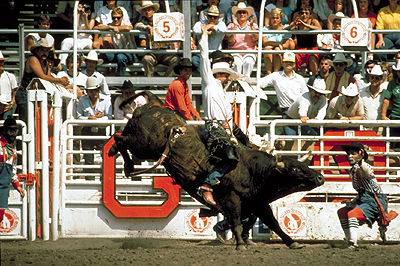
Tourism is also a major contributor to the Alberta economy. The spectacular scenery and year-round recreational facilities of the Rocky Mountain parks — particularly Banff, Jasper and Waterton national parks — draw hundreds of thousands of tourists annually from all over the world. In addition to the parks, many local attractions are also big draws, particularly the Calgary Stampede, a spectacular outdoor rodeo, carnival and musical festival held annually in July. Additionally, Alberta occasionally hosts special events such as the Commonwealth Games and the World University Games, which were hosted in Edmonton in 1978 and 1983 respectively, and the Winter Olympics, which were held in Calgary in 1988. These special events draw thousands of visitors, millions of dollars in revenue, and have resulted in infrastructure such as the Calgary Olympic Park, which continues to draw tourists.
Provincial Government
In Alberta, legislative power is vested in an 87-member, single-chamber, elected legislative assembly as well as a lieutenant-governor, appointed by the governor general on the advice of the prime minister and who acts as the Crown’s representative. However, as in other provinces, the traditional powers of the lieutenant-governor have in practice lapsed and he or she now serves primarily a ceremonial function. Executive power is exercised by a Cabinet of ministers selected by the premier, the leader of the political party commanding a majority in the legislative assembly. Each minister presides over one or more departments of government, known as ministries. (See also Politics in Alberta.)
Health
In July 1969 Alberta entered the federal medicare scheme and continues to provide publicly -funded universal healthcare. As in other provinces, the funding for Alberta’s healthcare is provided by both the Canadian federal and Alberta provincial governments. The Alberta Ministry of Health is responsible for health policy, and Alberta Health Services, a department of the Ministry of Health, is responsible for providing health services throughout the province.
Like other provinces, some privatization of healthcare exists in Alberta; nonessential services, such as optometry, dentistry and cosmetic surgery, are not part of the publicly -funded health care. Prescription medication is only partially covered by government funding. However, despite a trend towards increased privatization that has appeared since the cutbacks initiated by the Klein government in the 1990s, in compliance with the Canada Health Act of 1984, physicians are no longer able to engage in “extra billing” (i.e., charging for a service paid for by the provincial insurance plan) and Albertans continue to support publicly -funded healthcare.
Education
The first schools in Alberta were founded by Catholic and Protestant missionaries in the mid-1800s. The North-West Territories School Ordinance of 1884 established a dual system of Catholic and Protestant schooling based on the Quebec model. Religious groups such as Hutterites, Mennonites and the Christian Reformed Church gained their own educational privileges, either within the framework of public education or through self-supported private schools. However, subsequent Protestant settlement and the determination of territorial political leader F.W.A.G. Haultain saw the gradual weakening of religious duality in education.
Alberta became a province, and therefore became responsible for providing public education, in 1905. The new province established a system based on the Ontario model — one provincial educational system, allowing local provision for the dissenting religious minority, known as separate schools, but excluding mandatory province-wide separate schools. Ontario also provided the initial model for programs of study, course content and grade structures, a model that lasted until the 1930s. In the 1930s, however, Alberta made a number of innovations in their public education system and introduced the separate junior high school and a new course, social studies, which combined history, geography and political science. Alberta further altered the administration of rural education, expanded adult education and initiated programs for the economic and professional betterment of teachers in the 1930s.
Public education in Alberta is a shared responsibility of the provincial government, through the Ministry of Education, and the local public and separate school boards. As part of the financial cutbacks initiated by the Klein government, Alberta led the nation in reducing public expenditures on education in 1994.
Post-secondary education is under the jurisdiction of the Ministry of Innovation and Advanced Education. Provincial grants, which have been cut drastically since the 1990s, partially fund the public post-secondary institutions in the province; the remaining funds needed to operate come from tuition fees and other sources. The province's universities — Alberta, Calgary, Lethbridge, Athabasca, MacEwan and Mount Royal — are all public, nondenominational institutions. Other components of the public, post-secondary sector include the major technical institutes, the Northern Alberta Institute of Technology (NAIT) and the Southern Alberta Institute of Technology (SAIT), located in Edmonton and Calgary respectively. The province also has 11 comprehensive community colleges and two specialized arts and culture institutions — The Banff Centre and the Alberta College of Art and Design. These colleges offer a variety of university transfer, vocational and high school upgrading courses. Amendments in 1995 to the Public Colleges and Technical Institutes Acts permit the public colleges and technical institutions to offer applied degree programs, subject to ministerial approval.
Alberta is also home to a number of independent academic institutions. Ambrose University College, Burman University, Concordia University of Edmonton, The King’s University, St. Mary’s University and the Taylor University College and Seminary offer various undergraduate degrees, a few specialized graduate degrees, mostly in the liberal arts and specialized religious training.
Cultural Life
Cultural life in Alberta is coloured by a persistent "frontier ethos" that emphasizes economic materialism and rugged individualism. A rich physical landscape, diverse population and periodic governmental, corporate and private affluence have benefited the cultural sector. The Ministry of Culture, including the Alberta Foundation for the Arts, Alberta Historical Resources Foundation and the Government House Foundation, is the major provincial governing body for Alberta’s culture and arts. The primary source of funding for Alberta arts and culture is derived from the Alberta Lottery Fund and federal funding.
Visual Arts
Until the 1960s, visual arts in Alberta were centred in Calgary around the Provincial Institute of Technology and Art (now the Alberta College of Art and Design), and dominated by a British-inspired school of landscape painters. W.J. Phillips, H.G. Glyde, W.L. Stevenson and Illingworth Kerr were the most prominent artists to paint landscapes of the Alberta prairies, foothills and mountain countryside. Calgarians Maxwell Bates and Marion Nicoll were prominent Alberta painters and modernist exceptions to the traditional landscape artists.
From the 1960s into the 1980s, the abstract formalist theory of the New York school dominated northern Alberta painters such as Douglas Haynes at the University of Alberta. Abstract painters Robert Scott, Terrence Keller and Graham Peacock were among the many artists supported by the Edmonton Art Gallery, which also became the national leader in presenting and developing modern metal sculptors such as Peter Hyde and Alan Reynolds. The late 1980s saw a re-emergence of figurative painting and sculpture throughout the province and a strong community of printmakers in both Edmonton and Calgary.
The leading public galleries are the Art Gallery of Alberta in Edmonton and the Glenbow in Calgary, with strong regional support from the Southern Alberta Art Gallery in Lethbridge and the Art Gallery of Grande Prairie.
Performing Arts
The professional performing arts are centred in Edmonton and Calgary. Edmonton hosts a major summer folk festival (Edmonton Folk Fest), and the critically-acclaimed Edmonton International Jazz Festival. The Edmonton Symphony Orchestra and the Calgary Philharmonic Orchestra dominate orchestral music in the province and there are three opera companies in Alberta, the Edmonton Opera Association, the Calgary Opera Association and the Alberta Opera Touring Association, which specifically develops and performs opera for children. There is one ballet company in Alberta, the Alberta Ballet Company, with headquarters in Calgary.
Large professional theatre companies include the Citadel Theatre in Edmonton and Theatre Calgary. As well, Edmonton annually plays host to the International Fringe Theatre Festival, a week-long summertime festival of new and old plays at open-air venues and traditional playhouse settings. Many Alberta playwrights (including nationally-acclaimed John Murrell and Sharon Pollock) have worked with Alberta Theatre Projects, a Calgary company that has encouraged local writers and indigenous themes. Each summer Edmonton also hosts The Works Arts and Design Festival, which is the national pioneer of visual arts festivals.
Major facilities for the performing arts include the twin Jubilee auditoriums in Edmonton and Calgary (built for the 50th anniversary of provincehood in 1955), Edmonton's Citadel Theatre, the Timms Centre for the Arts (1995), the Winspear Centre (1996) and the EPCOR Centre for the Performing Arts in Calgary (1985). The Banff Centre School for Continuing Education has emerged as a nationally- and internationally-renowned training centre for young professionals in the performing arts.
Literary Arts
A number of commercially-successful and critically-acclaimed writers of both fiction and nonfiction come from Alberta, including novelists Robert Kroetsch, W.O. Mitchell and Rudy Wiebe. Nonfiction writing is dominated by popular and academic regional historians, including Grant Macewan, James Gray, Hugh Dempsey, James MacGregor and A.W. Cashman.
Communications
Alberta is home to eight major daily newspapers. The Calgary Herald is the largest, followed by the Edmonton Journal. The Edmonton Sun, Calgary Sun, Lethbridge Herald, Red Deer Advocate, Medicine Hat News and the Grande Prairie Daily Herald-Tribune are the other major daily newspapers in the province. All of Alberta’s newspapers are part of major Canadian newspaper chains. The Alberta Weekly Newspapers Association has 118 weekly community newspapers serving metropolitan, suburban and rural areas of Alberta and the Northwest Territories.
Historic Sites
Alberta is home to a network of 19 provincially-operated historic sites, interpretive centres and museums, covering a broad range of human and natural history. Additionally, there are over 200 community-run museums and over 30 local archives. The lotteries-funded Alberta Historical Resources Foundation assists local groups in heritage building preservation, historical markers, research and publishing efforts.
The major museums are the Glenbow in Calgary, the Provincial Museum of Alberta in Edmonton, the Royal Tyrrell Museum of Palaeontology at Drumheller and the Galt Museum in Lethbridge. Other major heritage attractions include the Head-Smashed-In Buffalo Jump World Heritage Site near Fort Macleod, the Ukrainian Cultural Heritage Village east of Edmonton, Fort Edmonton Park, Heritage Park in Calgary, Historic Fort Calgary, Historic Fort Macleod, Frank Slide Interpretive Centre and Medalta Potteries in Medicine Hat. The major historical archives in the province are the Provincial Archives of Alberta in Edmonton and the Glenbow Archives in Calgary.

 Share on Facebook
Share on Facebook Share on X
Share on X Share by Email
Share by Email Share on Google Classroom
Share on Google Classroom



